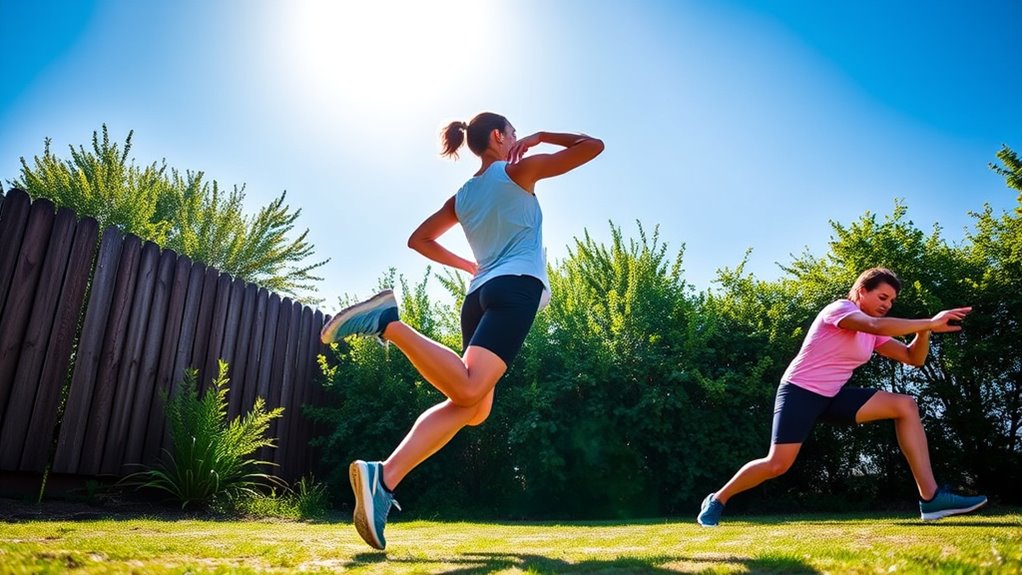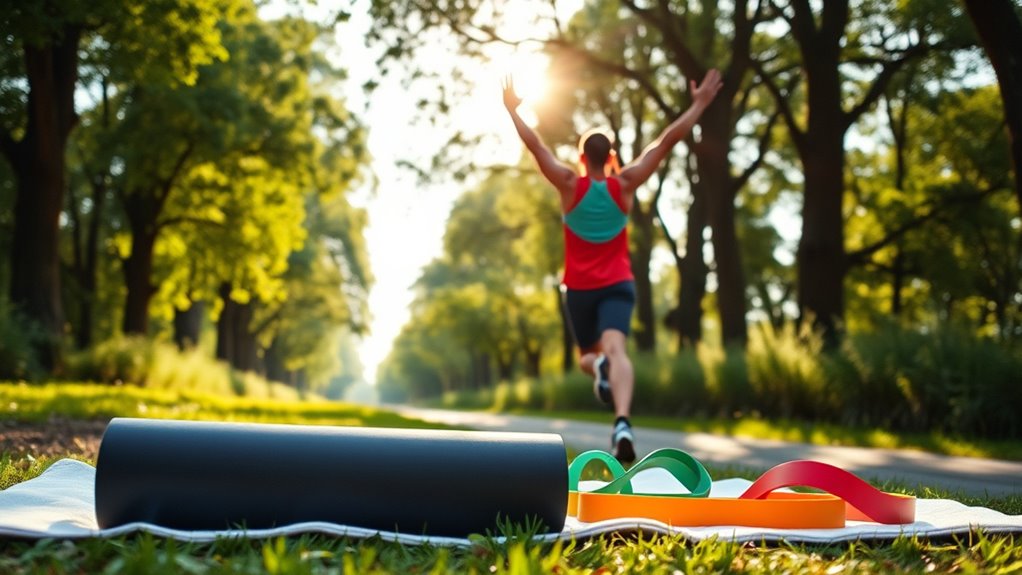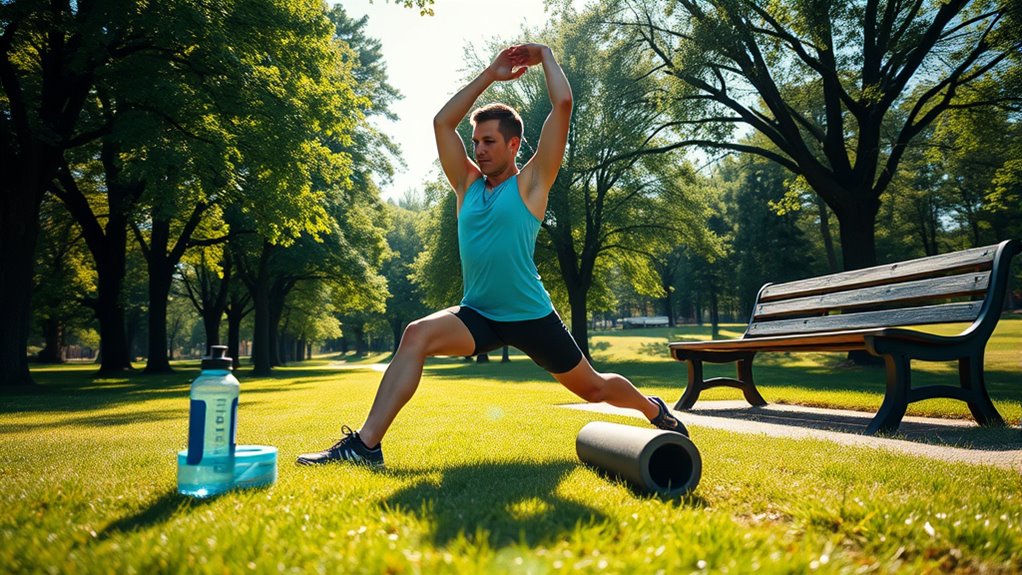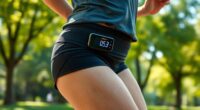After your run, spend under 10 minutes doing simple mobility exercises to enhance recovery and prevent injuries. Focus on gentle dynamic stretches for your calves, hamstrings, and hip flexors, followed by foam rolling to release tension. Incorporate deep diaphragmatic breathing to calm your nervous system and promote relaxation. Consistently practicing this routine helps increase flexibility and prepares your body for your next run. Keep exploring for a complete guide to maximize your recovery.
Key Takeaways
- Incorporate dynamic stretches like leg swings and lunges to warm muscles quickly.
- Use foam rolling on calves, hamstrings, and hip flexors for immediate tension relief.
- Focus on diaphragmatic breathing to promote relaxation and enhance recovery within minutes.
- Target tight areas with 30-second stretches, holding each position to improve flexibility efficiently.
- Keep movements controlled and deliberate, ensuring proper technique for maximum benefit in under 10 minutes.
Benefits of Post-Run Mobility Exercises

Post-run mobility exercises offer numerous benefits that can enhance your recovery and overall performance. By incorporating these routines into your post-run cooldown, you promote recovery enhancement, helping your muscles relax and reduce soreness. Improved mobility also supports injury prevention by maintaining joint flexibility and muscle balance, decreasing the risk of strains or imbalances that can lead to injury. These exercises help flush out metabolic waste products built up during running, speeding up the healing process. Additionally, regular mobility work can improve your range of motion, making future runs more efficient and comfortable. Incorporating specific techniques, such as essential oils for recovery, can further support your body’s healing process. Recognizing narcissism in your own behavior or in others can help you develop healthier interactions and boundaries. Taking just a few minutes after your run to focus on mobility yields long-term benefits, ensuring your body stays resilient, ready for your next workout, and less prone to setbacks. Engaging in a consistent post-run routine can also help you develop better body awareness and alignment over time, especially as research highlights that AI in healthcare technology benefits from AI-driven diagnostics.
Preparing Your Body for Mobility Work

To get the most out of your mobility exercises, it’s essential to prepare your body properly before starting. Begin with deep breathing techniques to calm your nervous system and increase oxygen flow, helping you relax and focus. Take slow, diaphragmatic breaths, inhaling through your nose and exhaling through your mouth. This not only reduces tension but also sharpens your mental focus, ensuring you stay present during your routine. Prioritize mental clarity by setting an intention for your mobility work, like improving flexibility or reducing tightness. Warming up your muscles with light movements or dynamic stretches can also enhance blood flow. This preparation primes your body, making your mobility work more effective and reducing the risk of injury. Regularly incorporating glycolic acid into your skincare routine can further support skin health and recovery after exercise. Additionally, paying attention to proper technique during mobility exercises can prevent strain and maximize benefits.
Key Movements to Include in Your Routine

Incorporating specific movements into your mobility routine targets key areas that often tighten after running. Focus on stretching techniques that loosen your hamstrings, calves, hip flexors, and quadriceps. Dynamic stretches like leg swings or gentle lunges help improve flexibility and prepare your muscles for recovery. Foam rolling is essential for releasing muscle tension and improving blood flow, especially in your calves, IT band, and quads. Spend about 30 seconds on each area, applying moderate pressure to break up tightness. These key movements enhance recovery, reduce soreness, and prevent future injuries. Additionally, sound healing science suggests that incorporating sound vibrations during your routine may further promote cellular regeneration and overall health. Keep your routine efficient by targeting these specific areas with targeted stretching techniques and foam rolling, ensuring your body stays agile and ready for your next run. Incorporating muscle recovery techniques can further optimize your post-run routine for better results and longevity. For optimal results, consider integrating stretching techniques that improve flexibility and aid in recovery.
Step-by-Step Guide to a 10-Minute Routine

A quick 10-minute routine can make a big difference after your run. Start with dynamic stretches to loosen up your muscles, then move into targeted movements to address tight spots. This simple approach helps you recover faster and stay flexible for your next workout. Incorporating mindful practices such as sustainable habits can further enhance your overall well-being and environmental impact.
Dynamic Stretches
Dynamic stretches are essential for gradually warming up your muscles and preparing your body for the post-run recovery. They promote muscle activation, increasing blood flow and flexibility, which helps prevent injuries. By moving through controlled, deliberate motions, you activate key muscle groups used during your run, reducing stiffness afterward. Focus on exercises like leg swings, walking lunges, and high knees, which target major muscles and joints. These movements loosen tight areas and improve range of motion, setting a strong foundation for effective recovery. Incorporate dynamic stretches into your routine to optimize muscle readiness and minimize the risk of strain or soreness. Keep the movements smooth and purposeful, ensuring your body shift seamlessly from activity to recovery.
Targeted Movements
After completing your dynamic stretches, focus on targeted movements that specifically address key muscle groups used during running. These movements help release tension and improve flexibility. Use stretching techniques like gentle hamstring and quad stretches, and incorporate foam rolling for deeper muscle release. By targeting areas like the calves, IT bands, and hip flexors, you enhance recovery and reduce soreness.
| Muscle Group | Targeted Movement / Technique |
|---|---|
| Hamstrings | Static stretch or foam roll |
| Calves | Calf raises or foam rolling |
| Hip Flexors | Lunge stretch or foam rolling |
| IT Band | Foam rolling along the outer thigh |
Tips for Consistency and Progression

To stay consistent and see steady progress, it’s essential to set realistic goals and create a structured routine that fits your schedule. Building a habit formation around your post-run mobility ensures you stick with it long-term. Keep your routine simple and manageable, so it becomes second nature. Progress gradually by increasing the intensity or duration of your mobility exercises over time, which helps prevent injuries and keeps your body adapting. Tracking your consistency can boost motivation and highlight improvements. Remember, consistency is key to injury prevention and developing better flexibility and mobility. By sticking to a regular routine, you’ll notice improvements faster and reduce the risk of setbacks. Stay committed, and your mobility gains will follow naturally.
Adjusting Your Routine for Different Needs

As your routine becomes more established, it’s important to tailor your mobility exercises to suit your specific needs and any changing circumstances. You can modify stretching variations to target areas that feel tight or sore, ensuring you’re addressing your unique post-run recovery. Incorporate different breathing techniques to enhance relaxation and improve oxygen flow, which can aid in muscle recovery. For example, deep diaphragmatic breathing can help release tension, while gentle exhalations during stretches deepen the stretch. Adjust the intensity and focus of your routine based on how your body feels—if you’re sore, prioritize gentle movements and breathing. Listening to your body and customizing your routine ensures better recovery and helps prevent injury, making your post-run routine even more effective.
Frequently Asked Questions
Can Post-Run Mobility Routines Prevent Injuries Long-Term?
You might wonder if post-run mobility routines prevent injuries long-term. They can considerably aid injury prevention by improving flexibility, reducing muscle tightness, and promoting better recovery. Consistently incorporating these routines supports your long-term health by maintaining joint and muscle function, lowering the risk of overuse injuries, and helping you stay active longer. Keep up with a quick post-run mobility routine to protect your body and enhance your overall running experience.
Is It Okay to Skip Mobility Exercises if I Feel Sore?
Imagine you’re sore after a run, and you wonder if skipping mobility exercises affects soreness management and recovery effectiveness. It’s okay to listen to your body, but skipping mobility might slow recovery and increase injury risk. Gentle stretches can help reduce soreness, so consider light mobility instead of skipping altogether. This approach supports better soreness management and speeds up recovery, ensuring you stay injury-free and ready for your next run.
How Does Post-Run Mobility Differ From Pre-Run Warm-Up?
Post-run mobility focuses on muscle recovery and enhancing joint flexibility after your run, helping prevent stiffness and injuries. In contrast, pre-run warm-ups aim to prepare your muscles and joints for activity, increasing blood flow and reducing strain. You should do mobility routines after running to relax muscles and improve flexibility, while warm-ups activate muscles beforehand. Both are essential, but they serve different purposes in your running routine.
Are There Specific Routines for Different Running Distances or Terrains?
Like tailoring a suit to fit perfectly, your routines should match your running distance and terrain. For trail runs, include terrain-specific stretches to target uneven surfaces, while road running may focus on hip flexibility. Distance-focused routines vary too; shorter runs need quick recovery, while longer runs demand more all-encompassing mobility. Adjust your post-run routine accordingly to optimize recovery and prevent injuries, making each session as effective as possible.
Can Mobility Work Replace Stretching or Foam Rolling?
You might wonder if mobility work can replace stretching benefits or foam rolling. While mobility exercises improve joint range and flexibility, they don’t fully replace stretching or foam rolling, which target muscle tightness and aid recovery. Incorporating all three offers a balanced approach: stretching enhances flexibility, foam rolling relieves muscle tension, and mobility work boosts joint health. Together, they optimize your post-run recovery and prevent injuries.
Conclusion
In just 10 minutes, you can markedly boost your recovery and prevent injuries. Skipping this routine might seem like a time-saver, but it’s an easy way to feel stronger and more energized after each run. Don’t let doubt hold you back—your body deserves this care. Make it a non-negotiable part of your routine, and you’ll notice better performance and less soreness. Invest in yourself; your future runs will thank you.









